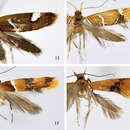fr
noms dans le fil d’Ariane


Promalactis is a genus of moths of the family Oecophoridae.[1]
The genus was established by Edward Meyrick in 1908. It currently comprises 179 valid species worldwide, distributed mainly in the Palaearctic and Oriental regions. China has the greatest diversity, with 101 recorded species.
Promalactis is represented by the combination of the following characters: the smooth head with metallic lustre, the lanceolate forewings with various dark or white markings against yellow to deep ochreous-brown ground colour; the variously shaped symmetrical or asymmetrical valvae and a narrow to very broad sacculus in the male genitalia; and a developed to ill-defined lamella postvaginalis and an elongate thin ductus bursae in the female genitalia.
Little is known about the biology of this genus. Meyrick reported that larvae fed on rotten wood or bark of Pinaceae and other trees.[2]
![]() This article incorporates text available under the CC BY 4.0 license.
This article incorporates text available under the CC BY 4.0 license.
Promalactis is a genus of moths of the family Oecophoridae.